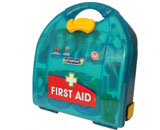 If you look through the list of contents for the first aid kits on this site, you will notice that some of them contain scissors and some contain ‘shears’. Most people think of sheers as something you cut hedges with, so we did a bit of research into the history of scissors to try and find out more about the different types.
If you look through the list of contents for the first aid kits on this site, you will notice that some of them contain scissors and some contain ‘shears’. Most people think of sheers as something you cut hedges with, so we did a bit of research into the history of scissors to try and find out more about the different types.
Scissors were invented in ancient Egypt in around 1500 BC. The oldest known scissors were discovered from archeological digs at what was once Mesopotamia. These are 3000–4000 years old "spring-scissors", comprising two blades joined by a curved flexible bronze strip. Between that day and now, scissors have come a long way, finding thousands of applications in fields such as engineering, agriculture, grooming, and medical, apart from regular everyday use in homes and offices.
Medical scissors today are made from stainless steel, nitinol, titanium and tungsten carbide. They come in a variety of shapes and sizes, each suitable for a particular use. The type of medical scissors is determined by the shape of the cutting blades. Straight, curved, bent, pointed, and blunt blades are used for different medical applications, such as dressing and surgery. Medical scissors can be grouped under three broad categories.
1. Bandage Scissors
Removing dressings requires the scissors to be slid under the bandage close to the skin. Bandage scissors, therefore, have blunt tips and angled blades. The blunt bottom edge can easily slide under the bandage without tearing the skin, which makes cutting bandages safe, quick and simple. Bandage scissors can have different sizes, although their shape stays the same, more or less.
2. Trauma Shears
These are also known as "tuff cuts" and are used by paramedics or emergency crews to cut through injured people's clothing. Trauma shears have plastic handles and curved cutting blades with longer lever arms. The blunt bottom edge can be easily slid under clothes or seat-belts without gouging the skin or aggravating the injury. Longer moment arms make it easy to cut thick clothing such as jeans or leather.
3. Surgical Scissors
Surgical scissors have multiple types and are manufactured from very hard stainless steel in order for them to have sharper edges that don’t easily go blunt. Some of them have tungsten carbide coating along the cutting edges to provide extra toughness. Surgical scissors can have many different types formed by different combinations of blunt, sharp, curved, and bent blades. Each type is suitable for a particular type of surgical procedure. Most of these scissors provide quick and safe cutting in delicate and confined spaces. Here are some common types of surgical scissors.
-
Dissecting Scissors: These are general-purpose surgical scissors used or cutting though the outer layer of skin or tissues during surgical procedures.
-
Metzenbaum Scissors: These are used in sensitive procedure such as heart surgery for cutting delicate tissues. They can be curved or straight with blunt tips and are manufactured using tungsten carbide. Metzenbaum scissors typically have longer shanks.
-
Mayo Scissors: Developed by Mayo Clinic surgeons, these scissors are made from stainless steel or titanium and are used for cutting fascia—a type of tissue that surrounds muscles, veins and organs. Mayo Scissors are generally 6 inches long and can have straight or curved blades.
-
Tenotomy Scissors: These are used for delicate operations such as eye surgery or neurosurgery. Tenotomy Scissors can be blunt or sharp, straight or curved, depending upon their applications, which generally involve maneuvering and cutting in small and sensitive areas. They typically have very small blades and very long handles.
-
Iris Scissors: Iris Scissors are small scissors with long handles. These are used in ophthalmic surgery where fine, detailed cutting work is required.
Other than the above types, there are Operating Scissors, Stitch Scissors, Sprig Scissors, and Plastic Surgery Scissors, each of which is used for specialized surgical applications. So, now you know how many types of medical scissors there are and what they are used for. Make sure you choose what you need.
You will find that scissors or shears are supplied with most of our office first aid kits - check out our range here
Posted in Office, Expert Commentary, Health and Safety